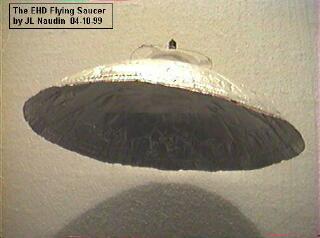
The E.H.D. Flying Saucer v1.0
By Jean-Louis Naudin
created on April 11, 1999 - JLN Labs - Last update April 18, 1999

The E.H.D. Flying Saucer v1.0
By Jean-Louis Naudin
created on April 11, 1999 - JLN
Labs - Last update April 18, 1999
The ElectroHydroDynamics ( E.H.D.) may open new ways in advanced propulsion. An EHD device uses a direct conversion of electrical energy into kinetic energy. A specially shaped electrostatic field creates an hydrostatic pressure (or motion) in dielectric media. If the media is a fluid like air (or aether), a flow is produced and this produces a motion of the device. A powered flow of medium (like air or aether) within a shaped electrostatic field adds energy to the system which is picked up (as potential difference) by electrodes and thus produces energy.
This has been fully used and tested by Biefeld, T.T.Brown and A.H. Bahnson in 1958. This has been fully detailled and documented in the book "L'effet Biefeld-Brown" by Alexandre Szames - (ASZ editions ISBN 2-913377-00-9 - EAN 9782913377004)
You will find below a very
simple device which shows that an EHD ship can work really. This
device is built with a thin aluminum cupola ( the shaped
electrode 250mm diameter) and positively charged at 25kV. Above
this shaped electrode there is an annular electrode ( 80mm
diameter, negatively charged or grounded ). This annular
electrode produces a non-uniform field and thus generates an
hydrostatic pressure above the arcuate electrode (the cupola).
The differential pressure in the medium between the upper surface
and the inner surface creates a mechanical force which propels
the device in one direction like the Coanda effect in a
fluid medium..
The most interesting thing to notice is that there is a direct
conversion of electrostatic energy into kinetic energy with
no moving parts. The motion of the medium around the ship can
be used for producing electrical energy and
self-sustaining the primary effect. In vacuum space the
surrounding plasma and the aether flow can be maintained in a
closed path with some special shaped electrode, so it is possible
to use an enhanced EHD ship as a space ship.
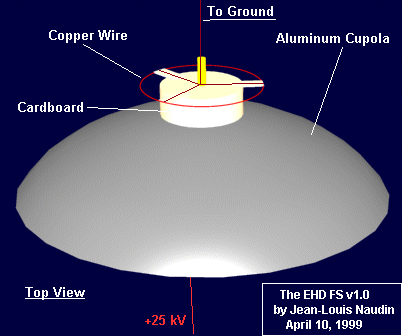
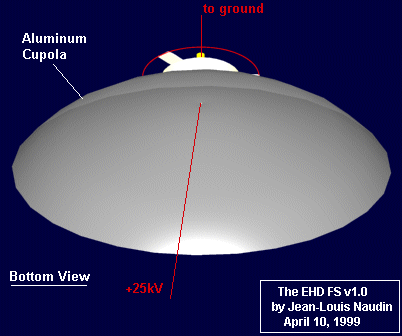

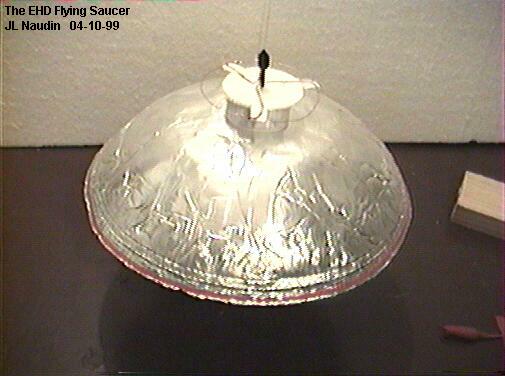
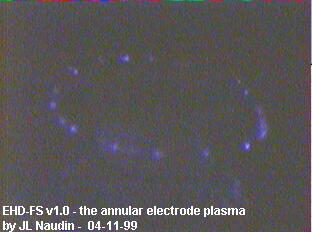

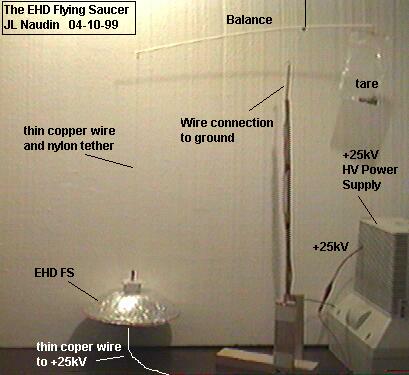
The picture above shows
the experimental setup :
The EHD-Flying Saucer v1.0 has been tethered with a nylon thread
on a plastic arm used as a simple balance hanged on the lab
ceiling. The annular electrode has been connected through a thin
copper wire on the negative pole (grounded). This thin wire
follows the nylon thread then was connected on a wooden pole (on
the right). The inner surface of the aluminum cupola has been
connected through a thin copper wire (fixed in the middle of the
cuppola) to the positive pole of the High Voltage generator
(+25kV). I have used the HV power supply from an old computer
color monitor (IBM 8512002) (at the bottom-right of the picture).
New : The EHD-FS works also very well with my new 30kVDC-Power supply (see the diagram and pictures)
When the HV is switched on, a NET THRUST UPWARD is applied on the EHD-FS (see the video below). I have also noticed that the EHD-FS keep its final level as long as the HV is sent and very often translates to the right as shown in the video. When the HV is switched off the EHD-FS lands...
The motion of the EHD-Flying Saucer v1.0 is undeniable and fast, this proves that the effect is real and can be used for building advanced spacecrafts with this kind of technology.
The weight reduction measured was about 14% at 25kV
See the RealVideo of the EHD-FS v1.0 flight demo
( if you don't have the RealPlayer 5.0, you may download it freely at : http://www.real.com/products/player/ )
Notes from Jean-Louis Naudin : WARNING !! this experiment uses High Voltages (25kV), use EXTREME CAUTION, always discharge and disconnect the power supply before touch it.
See also :
The EHD-Flying Saucer v2.0 ( pictures and video of the fly )...
The E.H.D. Flying Saucer Computer Simulations
Towards an enhanced EHD-Flying Saucer design...
The 30kVDC-Power supply for your EHD-FS (see the diagram and pictures)
Interesting documents :
J.R. Melcher, Field-Coupled Surface Waves: a Comparative Study of Surface Electrohydrodynamics and Magnetohydrodynamics, Cambridge, MA, USA, 1963
J.R. Melcher, Continuum Electromechanics, MIT Press, Cambrifge, MA, USA, 1982
Alexandre SZames : "L'effet Biefeld-Brown" - (ASZ editions ISBN 2-913377-00-9 - EAN 9782913377004)
Thomas Valone : "Electrogravitics Systems" ( Report on a new propulsion methodology) - ISBN 0-9641070-0-7
T.Townsend Brown : "Electrohydrodynamics (EHD)" - Electrokinetics, inc Bala Cynwyd, Pa - compiled March 23, 1960
Manson Rose : "The Flying Saucer : The application of the Biefield-Brown Effect to the solution of problems of space navigation" (1952)
![]() Email : JNaudin509@aol.com
Email : JNaudin509@aol.com
Return to the Advanced Propulsions Researches page